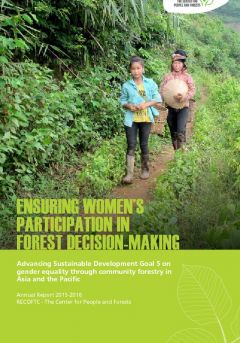Ensuring Women’s Participation in Forest Decision-Making: Annual report 2015-2016
Community forestry – as promoted by RECOFTC – provides an effective and cross-cutting solution that is aligned with the SDGs. This includes SDG goal 5 to achieve gender equality and empower all women and girls. RECOFTC has long understood that the long-term viability of community forest management is dependent on the inclusion of women. RECOFTC works to ensure that policies and programs of forestry stakeholders mainstream gender dimensions so that they are not at risk of creating or exacerbating inequalities, and ignoring women’s contribution to livelihoods.












